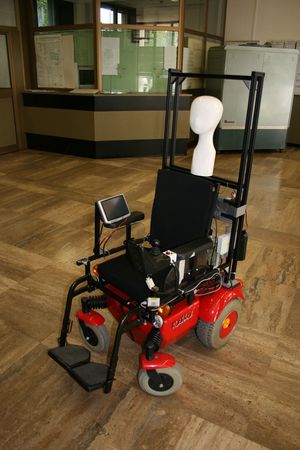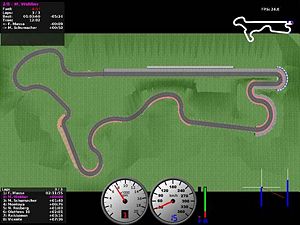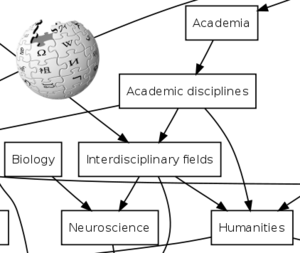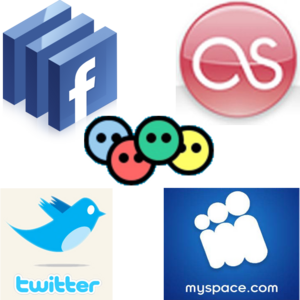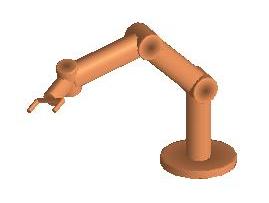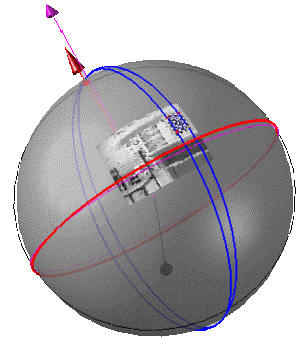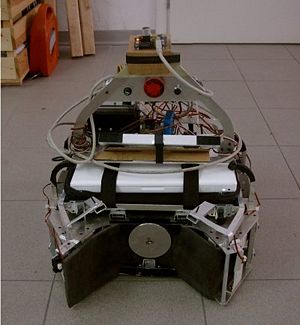First Level Theses
Here you can find proposals for first level thesis (7.5 CFU for each student). See Project Proposals for other kinds of projects and theses.
Contents
[hide]BioSignal Analysis
Brain-Computer Interface
| Title: | Real-time removal of ocular artifact from EEG | |
|---|---|---|
| Description: | In a BCI based on electroencephalogram (EEG), one of the most important sources of noise is related to ocular movements. Algorithms have been devised to cancel the effect of such artifacts. The project consists in the in the implementation in real time of an existing algorithm (or one newly developed) in order to improve the performance of a BCI.
| |
| Tutor: | Matteo Matteucci (email), Bernardo Dal Seno (email) | |
| Start: | Anytime | |
| Number of students: | 1 | |
| CFU: | 10-20 |
| Title: | Driving an autonomous wheelchair with a P300-based BCI | |
|---|---|---|
| Description: | This project pulls together different Airlab projects with the aim to drive an autonomous wheelchair (LURCH) with a BCI, through the development of key software modules. The work will be validated with live experiments.
| |
| Tutor: | Matteo Matteucci (email), Bernardo Dal Seno (email) | |
| Start: | Anytime | |
| Number of students: | 1 | |
| CFU: | 5-20 |
| Title: | Reproduction of an algorithm for the recognition of error potentials | |
|---|---|---|
| Description: | Error potentials (ErrPs) are event-related potentials present in the EEG (electroencephalogram) when a subject makes a mistake or when the machine a subject is interacting with works in an expected way. They could be used in the BCI field to improve the performance of a BCI by automatically detecting classification errors.
The project aims at reproducing algorithms for ErrP detection from the literature.
| |
| Tutor: | Matteo Matteucci (email), Bernardo Dal Seno (email) | |
| Start: | This project has already been assigned | |
| Number of students: | 1 | |
| CFU: | 5-15 |
Machine Learning
| Title: | Learning API for TORCS | |
|---|---|---|
| Description: | TORCS is a state-of-the-art open source racing simulator that represents an ideal bechmark for machine learning techniques. We already organized two successfull competitions based on TORCS where competitors have been asked to develop a controller using their preferred machine learning techniques. The goal of this project is to extend the existing C++ API (available here) to simplify the development of controller using a learning framework.
Such an extension can be partially developed by porting an existing Java API for TORCS that already provides a lot of functionalities for machine learning approaches. | |
| Tutor: | Daniele Loiacono (loiacono-AT-elet-DOT-polimi-DOT-it) | |
| Start: | Anytime | |
| Number of students: | 1 to 2 | |
| CFU: | 5 to 12.5 |
| Title: | EyeBot | |
|---|---|---|
| Description: | TORCS is a state-of-the-art open source racing simulator that represents an ideal bechmark for machine learning techniques. We already organized two successfull competitions based on TORCS where competitors have been asked to develop a controller using their preferred machine learning techniques. So far, the controller developed for TORCS used as input only information extracted directly from the state of the game. The goal of this project is to extend the existing controller API (see here) to use the visual information (e.g. the screenshots of the game) as input to the controllers. A successfull project will include both the development of the API and some basic imaga preprocessing to extract information from the images. | |
| Tutor: | Daniele Loiacono (loiacono-AT-elet-DOT-polimi-DOT-it), Alessandro Giusti (giusti-AT-elet-DOT-polimi-DOT-it), and Pierluigi Taddei (taddei-AT-elet-DOT-polimi-DOT-it) | |
| Start: | Anytime | |
| Number of students: | 1 to 2 | |
| CFU: | 5 to 12.5 |
| Title: | SmarTrack | |
|---|---|---|
| Description: | The generation of customized game content for each player is an attractive direction to improve the game experience in the next-generation computer games. In this scenario, Machine Learning could play an important role to provide automatically such customized game content.
The goal of this project is to apply machine learning techniques for the generation of customized tracks in TORCS, a state-of-the-art open source racing simulator. The project include different activities: the automatic generation of tracks, the section of relevant features to characterize a track and the analysis of an interest measure. | |
| Tutor: | Daniele Loiacono (loiacono-AT-elet-DOT-polimi-DOT-it) | |
| Start: | Anytime | |
| Number of students: | 1 to 2 | |
| CFU: | 5 to 12.5 |
| Title: | TORCS competition | |
|---|---|---|
| Description: | TORCS is a state-of-the-art open source racing simulator that represents an ideal bechmark for machine learning techniques. We already organized two successfull competitions based on TORCS where competitors have been asked to develop a controller using their preferred machine learning techniques.
The goal of this project is to apply any machine learning technique to develop a successfull controller following the competition rules (available here) | |
| Tutor: | Daniele Loiacono (loiacono-AT-elet-DOT-polimi-DOT-it) | |
| Start: | Anytime | |
| Number of students: | 1 to 2 | |
| CFU: | 5 to 12.5 |
Social Software and Semantic Web
| Wiki Page: | A firefox extension for semantic annotations | |
| Title: | A Firefox extension for semantic annotations | |
| Description: | Aim of this project is to develop a Firefox extension, to allow a community of users to annotate resources on the Web using a shared RDF vocabulary.
While browsing the Web, a user should be able to visualize the annotations relative to the page they are visiting, and to add new annotations as well. | |
| Tutor: | [[DavidLaniado | ]] (, , , , , , , , , , , , , , , , , , … further results ), [[DavideEynard | ]] (, , , , , , , , , , , , , , , , , , … further results ), [[DavideEynard | ]] (, , , , , , , , , , , , , , , , , , … further results ), [[RiccardoTasso | ]] (, , , , , , , , , , , , , , , , , , … further results ), [[RiccardoTasso | ]] (, , , , , , , , , , , , , , , , , , … further results ), [[MarcoColombetti | ]] (, , , , , , , , , , , , , , , , , , … further results ), [[MarcoColombetti | ]] (, , , , , , , , , , , , , , , , , , … further results ) )
| |
| Start: | ||
| Students: | 1 - 2 | |
| CFU: | 5 - 20 | |
| Research Area: | Social Software and Semantic Web | |
| Research Topic: | Semantic Annotations |
| Wiki Page: | Annotation aggregators from social applications | |
| Title: | Annotation aggregators from social applications | |
| Description: | Annotations are metadata published about a resource, such as tags in del.icio.us, comments on stumbleupon.com, or twines on Twine.com. One of the main problems of these annotations is that they are not expressed in a standard format: thus, any tool trying to aggregate information from these sources should be able to access each one of them in a different way.
The purpose of this project is to develop translation tools for different social annotation systems, collect their data in a common format (expressed using an ontology), and show them through a unique user interface, able to display different annotations (i.e. geo coordinates, dates, tags, etc.) in different ways. Moreover, tests and evaluations should be performed on this aggregator to show how efficient the queries are when performed on-the-fly or from an intermediate knowledge base. | |
| Tutor: | [[DavideEynard | ]] (, , , , , , , , , , , , , , , , , , … further results ), [[DavidLaniado | ]] (, , , , , , , , , , , , , , , , , , … further results ), [[DavidLaniado | ]] (, , , , , , , , , , , , , , , , , , … further results ), [[RiccardoTasso | ]] (, , , , , , , , , , , , , , , , , , … further results ), [[RiccardoTasso | ]] (, , , , , , , , , , , , , , , , , , … further results ), [[MarcoColombetti | ]] (, , , , , , , , , , , , , , , , , , … further results ), [[MarcoColombetti | ]] (, , , , , , , , , , , , , , , , , , … further results ) )
| |
| Start: | ||
| Students: | 1 - 2 | |
| CFU: | 5 - 20 | |
| Research Area: | Social Software and Semantic Web | |
| Research Topic: | Semantic Annotations |
| Wiki Page: | Extending a search engine with semantic information | |
| Title: | Extending a search engine with semantic information | |
| Description: | We are used to keyword-based search engines, where only documents matching the exact words in the query are retrieved. In a traditional search engine, if you submit the query "a dinosaur in a university in Lombardy" you won't probably find a document containing the phrase "a velociraptor in Politecnico di Milano", even though it's more or less what you were looking for.
Aim of this project is to expand a traditional search engine with semantic information, so that also documents containing words related to the ones in the query can be retrieved. Existing thesauri and ontologies can be used, as well as more dynamic and collaborative sources of knowledge such as user tags and wikipedia pages and categories. Starting points for this work can be the projects "SeQuEx - Semantic Query Expansion" and "Enriching search results with semantic metadata". | |
| Tutor: | [[DavidLaniado | ]] (, , , , , , , , , , , , , , , , , , … further results ), [[MarcoColombetti | ]] (, , , , , , , , , , , , , , , , , , … further results ), [[MarcoColombetti | ]] (, , , , , , , , , , , , , , , , , , … further results ) )
| |
| Start: | ||
| Students: | 1 - 2 | |
| CFU: | 5 - 20 | |
| Research Area: | Social Software and Semantic Web | |
| Research Topic: | Semantic Search |
| Wiki Page: | Mining wikipedia categories | |
| Title: | Wikipedia category map | |
| Description: | Wikipedia articles are organized in a hierarchy of categories, manually assigned by users. This process can be considered a huge effort for the collective categorization of human knowledge; the result is a wide and disordered graph which can provide precious information for a variety of applications (natural language processing, information retrieval, ontology building...).
In the project "Wikipedia Category Map" a tool has been developed to extract the graph of Wikipedia categories, to store it in RDF format and to interactively visualize and explore it. Aim of this project is to analyze the resulting graph for the extraction of semantic relationships; for example it is possible to define metrics of distance between topics in the graph, which can be useful for various purposes in information retrieval. | |
| Tutor: | [[DavidLaniado | ]] (, , , , , , , , , , , , , , , , , , … further results ), [[RiccardoTasso | ]] (, , , , , , , , , , , , , , , , , , … further results ), [[RiccardoTasso | ]] (, , , , , , , , , , , , , , , , , , … further results ), [[MarcoColombetti | ]] (, , , , , , , , , , , , , , , , , , … further results ), [[MarcoColombetti | ]] (, , , , , , , , , , , , , , , , , , … further results ) )
| |
| Start: | 7 July 2009 | |
| Students: | 1 - 2 | |
| CFU: | 5 - 20 | |
| Research Area: | Social Software and Semantic Web | |
| Research Topic: | Semantic Tagging |
| Wiki Page: | Social Network Data Extraction from Online Communities | |
| Title: | Social Network Data Extraction From Online Communities | |
| Description: | With the growth of the Web and the emergence of online communities, a huge amount of data regarding social relationships is now available, that was unthinkable until a few years ago. The network of connections may unveil precious information about communities structures and dynamics and the spreading of information in the Web.
Aim of this project is to design and develop a software tool to extract this kind of information from a single social network platform (decided by the student). It may be required also some kind of analysis or visual representation of the collected data. | |
| Tutor: | [[DavidLaniado | ]] (, , , , , , , , , , , , , , , , , , … further results ), [[RiccardoTasso | ]] (, , , , , , , , , , , , , , , , , , … further results ), [[RiccardoTasso | ]] (, , , , , , , , , , , , , , , , , , … further results ), [[MarcoColombetti | ]] (, , , , , , , , , , , , , , , , , , … further results ), [[MarcoColombetti | ]] (, , , , , , , , , , , , , , , , , , … further results ) )
| |
| Start: | ||
| Students: | 1 - 2 | |
| CFU: | 5 - 20 | |
| Research Area: | Social Software and Semantic Web | |
| Research Topic: | Social Network Analysis |
| Wiki Page: | Use case design and implementation for semantic annotations | |
| Title: | Use case design and implementation for semantic annotation | |
| Description: | Semantic annotations offer a variety of possibilities to enhance the user experience while browsing the Web. Aim of this project is to propose one scenario in which their usefulness is exploited for a specific community of users. In detail the project requires to design a simple ontology which describes some kind of domain to annotate resources on the Web and implement an interface to query it and insert assertions inside a semantic store (through SPARQL).
One possible example is the annotation of mp3 files available on the Web. They can be classified in genres or associated to datatype properties, such as rating, title, length and release date... also exploiting data already available in http://musicbrainz.org/ | |
| Tutor: | [[DavideEynard | ]] (, , , , , , , , , , , , , , , , , , … further results ), [[DavidLaniado | ]] (, , , , , , , , , , , , , , , , , , … further results ), [[DavidLaniado | ]] (, , , , , , , , , , , , , , , , , , … further results ), [[RiccardoTasso | ]] (, , , , , , , , , , , , , , , , , , … further results ), [[RiccardoTasso | ]] (, , , , , , , , , , , , , , , , , , … further results ), [[MarcoColombetti | ]] (, , , , , , , , , , , , , , , , , , … further results ), [[MarcoColombetti | ]] (, , , , , , , , , , , , , , , , , , … further results ) )
| |
| Start: | ||
| Students: | 1 - 2 | |
| CFU: | 5 - 10 | |
| Research Area: | Social Software and Semantic Web | |
| Research Topic: | Semantic Annotations |
| Wiki Page: | Wikipedia Page Social Network | |
| Title: | Wikipedia Page Social Network | |
| Description: | Goal of this project is to study the social network of Wikipedia pages, where two pages are connected if they share at least one main contributor. This social network can be studied to reveal interesting information; for example, it is possible to extract clusters of pages which apparently have nothing in common. A metric of distance between pages in the network can be defined, and compared with other metrics, such as the distance in the category tree or in the hyperlink graph. | |
| Tutor: | [[DavidLaniado | ]] (, , , , , , , , , , , , , , , , , , … further results ), [[RiccardoTasso | ]] (, , , , , , , , , , , , , , , , , , … further results ), [[RiccardoTasso | ]] (, , , , , , , , , , , , , , , , , , … further results ), [[MarcoColombetti | ]] (, , , , , , , , , , , , , , , , , , … further results ), [[MarcoColombetti | ]] (, , , , , , , , , , , , , , , , , , … further results ) )
| |
| Start: | ||
| Students: | 1 - 2 | |
| CFU: | 5 - 20 | |
| Research Area: | Social Software and Semantic Web | |
| Research Topic: | Social Network Analysis |
Robotics
| Title: | Simulation of 6-DOF Robot Manipulator | |
|---|---|---|
| Description: | The goal of this project is to develop a simulator for a 6-DOF robot manipulator, using the ode (open dynamics engine) library for simulating the rigid body dynamics. The project involves three different phases:
This project allows to put into practice what has been explained during the first part of the course of Robotics. The project can be turned into a thesis, by using the simulated manipulator to perform some learning experiments. | |
| Tutor: | Marcello Restelli (restelli-AT-elet-DOT-polimi-DOT-it) | |
| Start: | Anytime | |
| Number of students: | 2-3 | |
| CFU: | 10-15 |
| Title: | Calibration of IMU-camera system | |
|---|---|---|
| Description: | This work is about the problem to calibrate a system composed by an XSense
Inertial Measurement Unit and a Fire-i Camera. The pro ject will be focus on the problem to estimate both unknown rotation between the two devices and the extrinsic/intrinsic parameters of the camera. This algorithm allows to use the system for SLAM or robotics applications, like a wereable device for autonomous navigation or augmented reality.
| |
| Tutor: | Matteo Matteucci, Davide Migliore | |
| Start: | Anytime | |
| Number of students: | 1 | |
| CFU: | 5-20 |
| Title: | Robot games | |
|---|---|---|
| Description: | The goal of this activity is to develop an interactive game with robots using commercial devices such as the WII Mote (see the Robogames page)
Projects are available in different areas:
These projects allow to experiment with real mobile robots and real interaction devices. Parts of these projects can be considered as course projects. These projects can also be extended to cover course projects. | |
| Tutor: | Andrea Bonarini (bonarini-AT-elet-DOT-polimi-DOT-it) | |
| Start: | Anytime | |
| Number of students: | 1-2 | |
| CFU: | 7.5-12.5 |

